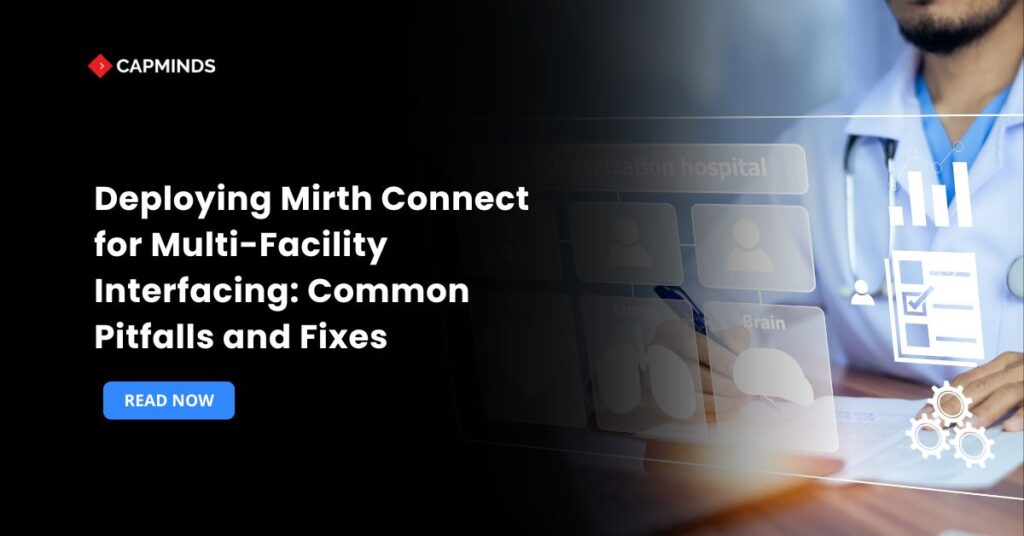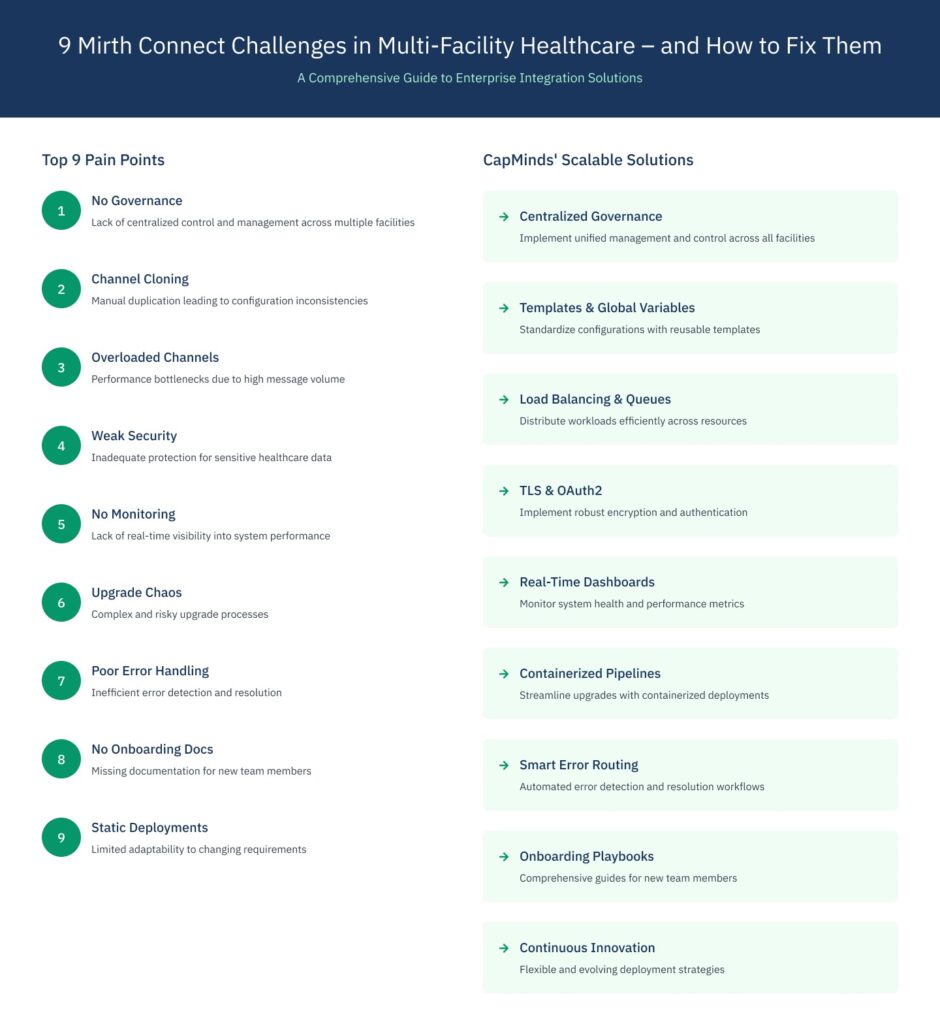Deploying Mirth Connect for Multi-Facility Interfacing: Common Pitfalls and Fixes
Data sharing across hospitals, labs, imaging centers, and clinics is not optional in the healthcare sector. Mirth Connect, a widely used integration engine, facilitates interoperability across diverse health IT systems by routing, converting, and transferring HL7, CCD, FHIR, and other healthcare data types.
However, when firms grow and expand across numerous sites, installing Mirth Connect introduces another level of complexity. Multi-facility rollouts often fail due to architectural and operational oversights, resulting in version control issues and inconsistent channel behaviors.
In this blog, you’ll know the most prevalent issues in multi-facility Mirth Connect installations and provide solutions for healthcare IT teams to create scalable, fault-tolerant interfaces.
1. Poor Interface Governance Across Facilities
One of the major challenges with multi-facility Mirth deployments is the lack of consistent governance. Interfaces soon become separate and unmanageable in the absence of a common strategy for channel naming, configuration management, and audit logging.
Solution – Implement centralized governance frameworks.
To prevent this:
- Define naming standards for channels, connectors, and transformations.
- To save XML outputs for all channels, use a version control system such as Git.
- Define role-based access for the development, testing, and deployment teams.
- Standardize logging and error handling processes across several sites.
Treating Mirth interfaces as code artifacts and imposing enterprise-level CI/CD procedures reduces fragmentation while improving maintainability.
2. Channel Cloning without Configuration Templates
In many cases, IT staff manually replicate channels across environments. This “clone-and-modify” strategy frequently results in configuration drift, hardcoded IP addresses, and inconsistent behavior in production.
Solution – Use Global Variables and Channel Templates
- Mirth Connect provides global scripts and channel templates that may be reused across interfaces.
- Global maps and system variables can be used to establish IP addresses, ports, and credentials particular to each facility.
- Create consistent templates for often-used scenarios such as ADT, lab orders, and radiology reports.
- Mirth’s scripting layer allows you to export settings as property files or environment variables.
This modular approach saves time during the onboarding of new facilities while also ensuring behavioral consistency.
3. Overloaded Channels and Bottlenecked Resources
As the number of linked facilities increases, channels designed for one or two endpoints frequently become overwhelmed. A single channel may process thousands of messages an hour, resulting in performance difficulties and data loss.
Solution – Scale Channels Horizontally
- Using load balancers, you may distribute message loads across different channels or Mirth instances.
- High-throughput connections should be implemented using message queuing systems such as RabbitMQ or Kafka.
- Wherever practical, use asynchronous processing to separate source and destination systems.
To identify bottlenecks early on, incorporate regular performance profiling and load testing into your Mirth maintenance routine.
4. Ignoring Security in Cross-facility Deployments
Multi-facility environments create additional attack surfaces, including unprotected TCP listeners, weak credentials, and a lack of encryption, which can compromise protected health information.
Solution – Harden Security using Best Practices.
Security must be built into each deployment layer:
- Use HTTPS and VPN tunnels for all external communications.
- Encrypt PHI at rest and in transit using TLS and AES protocols.
- Rotate passwords and certificates regularly.
- Enable audit logs to monitor access and message activities.
- Use Mirth’s SSL and OAuth2 capabilities to ensure safe authentication across systems.
5. Lack of Monitoring and Alerting
Most facilities find out too late that a channel has silently failed or is locked in an indefinite loop. Without real-time visibility, communication failures lead to clinical delays and compliance difficulties.
Solution – Integrate monitoring tools.
Use tools such as:
- Mirth provides built-in notifications for channel status changes and error levels.
- External log aggregators, such as ELK Stack or Splunk, provide long-term visibility.
- For real-time health checks, create custom dashboards with Prometheus and Grafana.
- Automated alerting enables you to address issues proactively rather than reactively.
6. Ignoring Version Compatibility During Upgrades
It is dangerous to roll out changes across different Mirth Connect instances without first comprehending the compatibility matrix. Channel scripts, Java dependencies, and connectors may function differently between versions.
Solution – Create a Versioned Deployment Pipeline.
- Maintain three environments: development, testing, and production, and fully test each update.
- Use containerization (such as Docker) to achieve consistent deployments.
- Keep track of the Mirth plugin versions and Java compatibility requirements.
- Document any breaking changes and update all dependent facilities accordingly.
Controlled rollouts avoid downtime and compatibility difficulties between connected locations.
7. Lack of Structured Error Handling
Unstructured error handling causes silent message failures, data inconsistencies, and compliance breaches. Many teams depend solely on logs rather than implementing effective exception management strategies.
Solution – Create Intelligent Error Routing mechanisms that can prevent quiet failures.
- Send unsuccessful communications to a designated error channel.
- Include metadata elements such as facility ID, message type, and timestamp to facilitate reprocessing.
- Notify appropriate IT departments via email or SMS with Mirth alerts or custom scripts.
- Monitor error resolution in a centralized dashboard or ticketing system.
This organized technique significantly lowers message loss while increasing system confidence.
8. No Documentation for Onboarding New Facilities
Adding a new facility should be a repeatable procedure. However, without documentation, integration becomes scattered, slow, and error-prone.
Solution: Create a facility onboarding playbook.
- Integration checklists, such as IP ranges, system specifications, test data, and contact points
- Standard interface templates depending on message types like ADT, ORU, ORM.
- Steps for channel import and export using Mirth’s Administrator or command-line tools.
- Sample message validations for QA approval.
A well-documented onboarding process lowers reliance on tribal knowledge and accelerates the time to go live.
9. Using Mirth as a Static Tool
Many organizations put up Mirth and leave it alone for years. However, integration needs alter over time as new data formats, API endpoints, and compliance standards emerge.
Solution – Evolve via standards and innovation.
Remain proactive by:
- Participating in Mirth/NextGen community forums to share best practices.
- Regularly upgrading to the most recent stable versions.
- Teach your team about FHIR, OAuth2, HL7 v3, and API-based interoperability.
- Experimenting with scripting enhancements to decrease manual workload.
Consider Mirth to be an ever-improving integration platform, rather than a static tool.
Related: The Ultimate Guide to Creating Healthcare Data Hub with AWS and Mirth Connect
Scale Smart With CapMinds Mirth Connect Integration Services
Managing interoperability across multiple healthcare facilities requires more than just setting up channels; it demands a scalable, secure, and standardized integration strategy.
At CapMinds, we specialize in enterprise-grade Mirth Connect implementation and optimization to help healthcare networks overcome the challenges.
With CapMinds, you benefit from:
- Centralized Interface Governance – Standardized naming conventions, version control with Git, and CI/CD pipelines
- Reusable Templates & Scripts – Rapid rollout using global maps, channel templates, and property-based configs
- High-Throughput Scaling – Load balancing, queuing systems (RabbitMQ, Kafka), and performance tuning
- End-to-End Security – TLS/SSL encryption, OAuth2 authentication, and secure message routing
- Monitoring & Alerting – Real-time dashboards with Grafana, ELK stack integration, and auto-alerts
- Versioned Rollouts – Dockerized deployments, QA sandboxes, and full regression testing
- Error Routing & Documentation – Custom error channels, alert workflows, and onboarding playbooks
Contact CapMinds to build robust, future-ready healthcare interfaces across all your locations.





